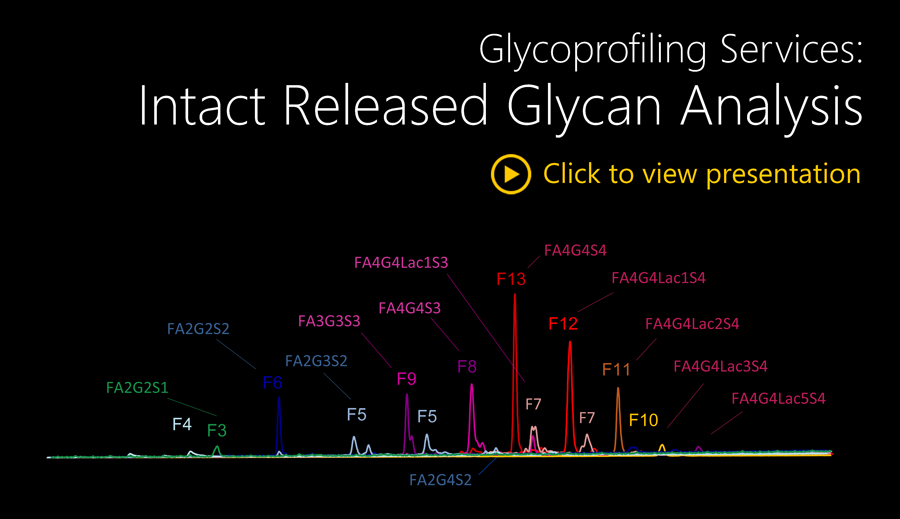Glycan Analysis Services - Level 1
WAX profiling
The weak anion exchange high-performance liquid chromatography (WAX-HPLC) provides glycan charge profiles. Negatively charged glycans often play a critical role in the function of a glycoprotein. Glycan charges are usually due to sialic acids, however they can also result from sulphation or phosphorylation of monosaccharide building blocks. Biopharmaceuticals often contain two main types of sialic acid; N-acetyl-neuraminic acid (Neu5Ac) and N-glycolyl-neuraminic acid (Neu5Gc). Neu5Ac is found in both human and non-human cells, whereas Neu5Gc is not present on human glycoproteins. The biopharmaceuticals efficacy, serum half-life and immunogenicity are impacted by both the abundance and the type of sialylation. Consequently, sialylation is a glycosylation critical quality attribute (GCQA).
In addition to Level 1: HILIC profiling and Quantitative Sialic Acid Analysis, the Level 1: WAX profiling (glycan charge profile) is also an important parameter for biotherapeutic protein monitoring.

This module provides WAX-HPLC charge profiles with the relative proportion of the mono-, di-, tri- and tetra-sialylated glycan structures. The analysis will be performed on single or triplicate releases of samples (typically 5-100 µg for each release), an equivalent amount (by volume) of sample buffer negative control, and alongside Ludger's system suitability standards, positive and negative controls.
This module is suitable for:
- sialylated samples
- quality control - profile comparisons to monitor charge distribution
- monitoring batch to batch consistency
- comparability studies
In order to gain more detailed information on the glycan structures and their relative proportions Level 2 Detailed Characterisation is required.
Sample types:
- Biopharmaceuticals: glycoprotein hormones (e.g. follicle stimulating hormone (FSH) and erythropoietin (EPO), Fc fusion proteins, monoclonal antibodies (mAbs), vaccines.
- Cells: mammalian cell lines, bacterial cell components
- Biological fluids, tissues and others
- Glycoproteins set in SDS-gel (N-glycans only)
- COVID-19 patient samples (e.g. plasma, tissues)
- SARS-CoV-2 infected cell lines
Workflow for Level 1 WAX profiling

N-glycans are released from glycoprotein by digestion with PNGAse F or PNGAse A.
O-glycans are released from glycoprotein by hydrazinolysis or Orela reagent.
Released glycans are fluorescently labelled with 2-AB purified and analysed on a LudgerSep-C3 weak anion exchange (WAX) column.
WAX-HPLC provides charge profiles for profile comparison between batches where glycan separation is based on glycan charge.
Report
Final report contains:
- WAX-HPLC profiles for system suitability standards and Ludger positive controls
- WAX-HPLC profiles for client samples and buffer negative controls
- Relative proportions of the mono-, di-, tri- and tetra-sialylated glycan structures
Module Level 1: WAX profiling has:
2 options for N-glycans profiling to choose between:
- G-L1N-WAX - Option 1: Glycoprofiling on a single sample releases + formulation buffer + Ludger controls
- G-L1N-WAX - Option 2: Glycoprofiling on triplicate sample releases + formulation buffer + Ludger controls
2 options for O-glycans profiling to choose between:
- G-L1O-WAX-OHy - Option 1: Glycoprofiling on triplicate sample releases + formulation buffer + Ludger controls.
O-glycan release by hydrazinolysis.
- G-L1N-WAX-ORe - Option 2: Glycoprofiling on triplicate sample releases + formulation buffer + Ludger controls.
O-glycan release by Orela.

